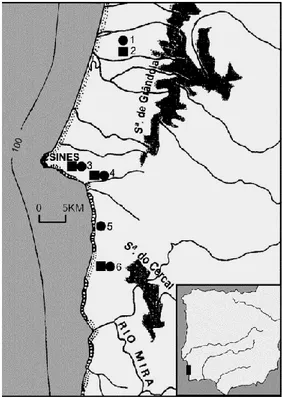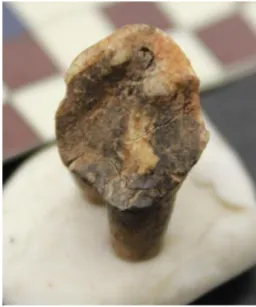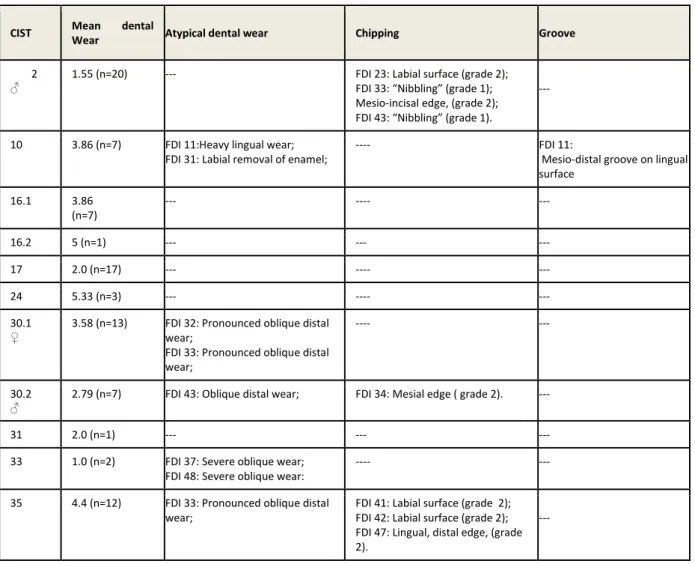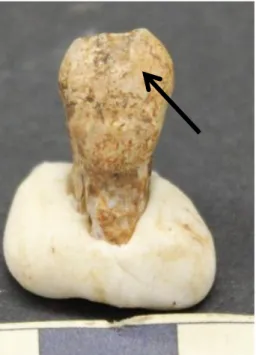Bull Int Assoc Paleodont. Volume 10, Number 1, 2016
www.paleodontology.com
31
Short report: Evidence of non-masticatory dental use in
Bronze Age individuals exhumed from the Necropolis of
Casas Velhas (Portugal)
• Ana Maria Silva (1,2,4), Pedro Gil (1), Joaquina Soares (2,3) and Carlos Tavares
da Silva (2,3) •
1 – Prehistory Laboratory, CIAS – Department of Life Science, University of Coimbra, 3000-456 Coimbra, Portugal
2 – UNIARQ – WAPS. Centro de Arqueologia da Universidade de Lisboa 3 – MAEDS – Museu de Arqueologia e Etnografia do Distrito de Setúbal
4 – Laboratory of Forensic Anthropology, CEF – Departamento Ciências da Vida, Universidade de Coimbra
Address for correspondence:
Ana Maria Silva
Department of Life Science University of Coimbra 3000-456 Coimbra, Portugal E-mail: amgsilva@antrop.uc.pt
Bull Int Assoc Paleodont. 2016;10(1):31-38.
Abstract
The Southwest Iberian Middle Bronze Age culture, although widespread in southern Portugal and nearby areas of southwest Spain in the Middle Bronze Age, is characterised by the scarcity of preserved human remains. Recent reanalysis of the human remains unearthed from the grave cists of the necropolis of Casas Velhas (Melides, Portugal), with a minimal number of 21 individuals (19 adults and 2 non-adults), included the analysis of the dental remains to assess information about non-masticatory behaviour and oral pathology of these individuals. Dental data scored included dental wear, oral lesions (chipping and grooves), and atypical dental wear
Bull Int Assoc Paleodont. Volume 10, Number 1, 2016
www.paleodontology.com
32
patterns. The mean dental wear is low (2.93; n=90), although 16 teeth exhibit severe dental wear (> grade 4). Only one tooth displays a cariogenic lesion (1/82). Atypical dental wear patterns, chipping and the presence of grooves were recorded in six individuals (6/11 = 54.5%). The predominant anterior pattern of unusual dental wear and oral lesions were interpreted as highly suggestive of the use of anterior teeth in extra-masticatory activities. The chips observed in posterior teeth were interpreted as mainly resulting from masticatory activities, as the ingestion of hard foods. The obtained results were discussed in terms of a more vegetarian diet proposed for these individuals, as well as, the use of vegetable products, as the treatment of vegetable fibres in daily activities.
Keywords: Non-masticatory dental use; Chipping; grooves; Southwest Iberian Middle Bronze
Bull Int Assoc Paleodont. Volume 10, Number 1, 2016
www.paleodontology.com
33
Introduction
The necropolis of Casas Velhas (Melides, Portugal), Figure 1, discovered during the 1970s, is comprised by 35 small stone cists, vastly destroyed by farming activities, and mainly composed of four upright slabs of limestone or ferruginous (Figure 2). The cultural context of this cemetery is the Southwest Iberian Bronze Age, widespread in southern Portugal and nearby areas of southwest Spain in the Middle Bronze Age (1-2). It is characterised by the paucity of preserved human remains and thus, the anthropological knowledge of these human populations. In funerary terms, this culture is characterized by predominantly individual burials deposited in foetal position, mostly inside small stone cists (less than 1m), sometimes with funerary ceramic vessels, metallic objects and/or faunal remains. To date, Casas Velhas Necropolis (NCV) represents the site with more human remains preserved of this culture from Portuguese territory (3). Of the 35 graves, 20 revealed human bones, but only 16 were available for detailed anthropological analysis. Of these, 12 were individuals, 3 double and 1 triple, corresponding to a minimum number of 21 individuals, 19 adults and 2 non-adults. The Bronze Age chronology of these human remains were confirmed by the dating of two human bone samples (cist 14 - 3255±55BP; 1670-1410 cal BC - 2 sigma; OxA-5531; and cist 35 - 3260±60BP; 1680-1415 cal BC - 2 sigma; Beta-127904) (4-6).
The aim of this work is the analysis of the dental remains unearthed from the Necropolis of Casas Velhas to assess information about non-masticatory behaviour and oral pathology of these individuals. Dental data scored include dental wear, oral lesions (chipping and grooves), and atypical dental wear patterns.
Material and Methods
From the 19 adult individuals exhumed, only 11 present dental remains (n= 90). All teeth were recovered as isolated ones. They were examined macroscopically and with hand lens. Wear patterns were recorded according to Smith (7) adapted by Silva (8); unusual wear following the recommendations of Molnar (9), chipping and notching were scored according to Bonfiglioli et al. (10)
Figure 1 Geographic location of the Necropolis of
Casas Velhas (Number 1).
Figure 2 Small stone cist number 30 from the
Necropolis of Casas Velhas (NCV).
Results
The mean dental wear is 2.93 (n=90), although 16 teeth exhibit severe dental wear (> grade 4). Only one tooth displays a cariogenic lesion (1/82). Atypical dental wear patterns, chipping and the presence of grooves were recorded in six individuals (6/11 = 54.5%). The former one
Bull Int Assoc Paleodont. Volume 10, Number 1, 2016
www.paleodontology.com
34
include pronounced oblique-distal wear on anterior (n=6; Figure 3) and posterior teeth (n=2; Figure 4; Table 1), corresponding to five individuals. Both affected posterior teeth belong to the same individual but are also the only preserved teeth from this skeleton. Another unusual wear pattern was observed in two anterior teeth preserved from the adult of unknown sex unearthed from cist 10. The lower left central incisor shows the removal of a large area of enamel in its labial surface (Figure 5). The upper right central incisor exhibits a groove running in mesio-distal direction associated with a severe lingual wear (Figure 5). The remaining five posterior teeth of this skeleton display dental wear between grades 2 and 4. So, atypical dental wear was observed in 26.1% (6/23) of the anterior teeth and 2.98% (2/67) of the posterior teeth of NCV and, respectively, 3.5% (1/29) and 11.5% (7/61) of the upper and lower teeth.
Figure 3 Labial view of tooth 33 recovered from
cist 35 of NCV with pronounced oblique/distal wear.
Chipping was recorded in five anterior and two posterior teeth (Figure 6), corresponding to three individuals: one presented defects only in anterior teeth, another in anterior and posterior teeth and the last one only in a posterior tooth. These defects correspond to 21.7% (5/23) of the anterior teeth, 2.98% (2/67) of the posterior teeth, 3.5% (1/29) of the upper teeth and 9.8% (6/61) of the lower teeth preserved from NCV. The lower left canine of the adult male exhumed from cist 2 exhibit two defects: a
nibbling effect on his occlusal surface besides a chip on its mesio-incisal edge.
Figure 4 Severe oblique wear observed in tooth 37
exhumed from cist 33 of NCV.
Figure 5 Teeth 31 (labial view) and 11 (lingual view)
recovered from cist 10 of NCV. Note the removal of the enamel of labial surface of 31 and the severe wear and the medial-distal groove of 11.
Bull Int Assoc Paleodont. Volume 10, Number 1, 2016
www.paleodontology.com
35
Table 1. Results of the analysis of the dental remains unearthed from NCV.
CIST Mean dental
Wear Atypical dental wear Chipping Groove
2 ♂
1.55 (n=20) --- FDI 23: Labial surface (grade 2); FDI 33: “Nibbling” (grade 1); Mesio-incisal edge, (grade 2); FDI 43: “Nibbling” (grade 1).
---
10 3.86 (n=7) FDI 11:Heavy lingual wear; FDI 31: Labial removal of enamel;
---- FDI 11:
Mesio-distal groove on lingual surface 16.1 3.86 (n=7) --- ---- --- 16.2 5 (n=1) --- --- --- 17 2.0 (n=17) --- ---- --- 24 5.33 (n=3) --- ---- --- 30.1
♀ 3.58 (n=13) FDI 32: Pronounced oblique distal wear; FDI 33: Pronounced oblique distal wear;
---- ---
30.2
♂ 2.79 (n=7) FDI 43: Oblique distal wear; FDI 34: Mesial edge ( grade 2). ---
31 2.0 (n=1) --- --- ---
33 1.0 (n=2) FDI 37: Severe oblique wear; FDI 48: Severe oblique wear:
---- ---
35 4.4 (n=12) FDI 33: Pronounced oblique distal wear;
FDI 41: Labial surface (grade 2); FDI 42: Labial surface (grade 2); FDI 47: Lingual, distal edge, (grade 2).
---
Considering all the detected oral lesions, atypical dental wear and the presence of a groove were observed in one individual and atypical dental wear associated with chipping in two. Unfortunately, the nature of the sample (poorly preserved and isolated teeth) did not allowed a more detailed analysis of the relation between oral lesions in teeth of the same individual or sex differences.
Discussion
The mean dental wear of these individuals is low, 2.93 (n=90), although 16 teeth exhibit severe dental wear (> grade 4). Only one cariogenic lesion (1/82) was detected. This dental profile has to be considered with caution since several parameters as antemortem tooth loss, periapical lesions and periodontal disease
are impossible to evaluate due to the almost complete absence of maxilla bone. The presence of individuals with a severe dental wear, including anterior teeth associated with a low frequency of cariogenic lesions was previously document for coeval samples, such as, Las Minitas (Spain, 11), Vinha do Casão (12), Sepultura do Sobreiro (13) and Las Palomas (Spain, 14). For the Necrópole de Las Minitas these were interpreted as a consequence from a more vegetarian diet (with less meat), low in carbohydrates, rich in fibres and by the presence of undercooked food and contaminants (11).
Chipping has been attributed to both masticatory and non-masticatory activities (15-18). In NCV sample, the anterior teeth are more damaged than posterior one and the lower than the upper ones. The presence of food contaminants and the ingestion of hard
Bull Int Assoc Paleodont. Volume 10, Number 1, 2016
www.paleodontology.com
36
foods, such as fruit stones, shells, could explain the chips observed in the posterior teeth of these individuals. The anterior chipping pattern is, on the other hand, more suggestive of the use of teeth in daily activities. This behaviour is also sustained by the atypical dental wear observed in several anterior teeth, as the pronounced oblique distal wear. Tooth 33 of the young adult male exhumed from cist 2 stands out by revealing small microfactures in its occlusal surface - nibbling effect – and the presence of a chip on its mesial-incisal edge. All these fractures resulted from repeated dental stress.
All these data could result from the more vegetarian diet proposed for these populations, as well as, the increase use of teeth in working of vegetable fibres, although there is no regional archaeological evidence of their use. Future isotopic analysis through stable carbon and nitrogen isotope analysis from bone collagen would be useful to confirm the abovementioned paleodietary inferences. Evidence of task activity could be proposed for the dental alterations registered for the adult of unknown sex unearthed from cist 10. The removal of a large area of enamel in the labial surface of tooth 31 and the groove associated with severe lingual wear on tooth 11 suggest the friction of an unknown material (vegetable nature?) between the lingual surface of upper anterior teeth and labial surface of lower anterior teeth in a mesial-distal direction. Recently, other Bronze Age funerary contexts revealed the presence of grooves associated with non-alimentary tooth use. In 2016, Fidalgo et al. (19) described a groove with a labial-lingual direction on the upper right canine from a female skeleton from the Hypogeum of Torre Velhas 3 associated with a severe lingual wear interpreted as evidence of non-masticatory activities. Additional evidence of these activities come from pit 1212 of this Necropolis, were an interproximal/occlusal groove was observed on the mesial side of the upper left second premolar from female 969 (20). In pit 102 from Monte do Vale de Ouro 2, lingual sulcus on the cement-enamel junction of two upper lateral incisors were interpreted as probably resulting from the continuous friction of some kind of thread or wire (21). So, there is an increase evidence of occlusal grooving in Bronze Age populations and thus, the use of teeth in non-masticatory activities. More precise information might have been gained if more dental data per individual were available,
which was not possible due to their low preservation and isolated nature.
Figure 6 Chipping in the labial surface of tooth 23
unearthed from cist 2 of NCV.
Conclusions
The examination of the dental remains of these individuals has contributed to relevant data about their masticatory and non-masticatory activities. Through macroscopically analysis, atypical dental wear and oral lesions, chips and groove, were documented. The lesions scored in anterior teeth, as unusual dental wear, chipping and groove were interpreted as highly suggestive of the use of anterior teeth in extra-masticatory activities. The chips observed in posterior teeth may have resulted from the ingestion of hard foods. All these can result from the proposed higher vegetarian diet of individuals of the Southwest Iberian Middle Bronze Age culture and thus, the increase use of plants, in diet and in the treatment of vegetable fibres for daily activities.
In sum, although the causing agents of all these patterns and lesions remain tentative, their descriptions are significant for the interpretation of past human behaviour including cultural or habitual activities. Future studies, as isotopic analysis and microwear analysis, should provide more data for the interpretation of the lifestyle of these past populations.
Bull Int Assoc Paleodont. Volume 10, Number 1, 2016
www.paleodontology.com
37
Acknowledgments
The authors wish to thank Marin Vodanović for the invitation to publish this work, a poster presented in the International Dental Anthropology Scientific Symposium Zagreb 2016; the Museu de Arqueologia e Etnologia do Distrito de Setúbal for permitting the study of the human remains; CIAS for financial support (PEst-OE/SADG/UI0283/2013); Inês Leandro and Lucy Evangelista for revisions and suggestion of previous version of the manuscript; first author thanks PPPA and GZMB.
References
1. Schubart H. Die Kultur (Madrider Forschungen, 9). Berlin: Walter de Gruytern; 1975. 2. T v v C, J. P é- ó á . L : G Á Sines; 1981. 3. v AM, G P, D y C. A N óp de Cistas C V : ó v p pó ó u . ú A qu óg : in press; 2016.
4. Soares J, Tavares da Silva C. O Alentejo Litoral no contexto da Idade do Bronze do Sudoeste P u . : u P uguê Mu u , Lisboa, editor. A Idade do Bronze em Portugal: Discursos de Poder. p. 136-139. 5. Soares J, Tavares da Silva C. From the collapse
of the Chalcolithic mode of production to the development of the Bronze Age societies in the South-West of Iberian Peninsula. In: Jorge, VO, editor. Existe uma Idade do Bronze A â ? (T A qu g , 10). L : u P uguê A qu g . 1998. p. 231-245.
6. T v v C, J. P á fu á P L Alentejano: o Monumento II do Pessegueiro. E u A qu óg O 2009; 17: 389 - 420.
7. Smith BH. Patterns of molar wear in hunter-gatheres and agriculturalists. American Journal of Physical Anthropology. 1984; 63:39 - 84.
8. Silva AM. O Hipogeu de Monte Canelas I (IV – é .C.): E u p óg
p pu çã u xu . T í . P v Ap ã P góg C p C íf . C : Departamento de Antropologia, Faculdade de C ê T g U v Coimbra. Unpublished Thesis: 1996.
9. Molnar P. Dental wear and oral pathology: possible evidence and consequences of habitual use of teeth in a Swedish Neolithic sample. American Journal of Physical Anthropology. 2008; 136: 423 – 431.
10. Bonfiglioli B, Mariotti V, Facchini F, Belcastro MG, Condemi S. Masticatory and non.masticatory dental modifications in the Epipalaeolithic Necropolis of Taforalt (Morocco). International Journal of Osteoarchaeology. 2004; 14: 448 – 456. 11. P vó v . E u fu á
Edad del Bronce en la Tierra de Barros: Una p x ó qu gí L M . M A qu gí Ex ñ 9; 2008.
12. G MV, G RV; ã C , M JL; Cunha AS; Silva CT; Gil FB, Guerra MF, G. A N óp V C ã (Vilamoura, Algarve). Trabalhos de A qu g 2, u P uguê P ó Cu u . 1986.
13. Gomes MV, Paulo LC, Ferreira SD, Ramos J. Sepultura da Idade do Bronze da Sobreira (M ã , L g ). R v P ugu Arqueologia. 2002; 5 (2): 191-218.
14. Gil-Mascarell M ; R ígu AD, E íqu JJN. Enterramientos en cista de la Edad del Bronze en la Baja Extremadura. Saguntum: P p L A qu gí Valencia. 1986; 20: 9-42.
15. Scott, RG, Winn JR. Dental Chipping: contrasting patterns of microtrauma in Inuit and European populations. International Journal of Osteoarchaeology. 2011; 21: 723 – 731.
16. Belcastro G, Rastelli E, Mariotti V, Consiglio C, Facchini F, Bonfiglioli B, Continuity or discontinuity of the life-style in central Italy during the roman imperial age-early middle Ages transition: diet, health, and Behavior. American Journal of Physical Anthropology. 2007; 132: 381 – 394.
17. Minozzi S, Manzi G, Ricci F, Lernia S, Borgognini Tarli S. Nonalimentary tooth use in prehistory: an example from early Holocene in Central Sahara (Uan Muhuggiag, Tadrart
Bull Int Assoc Paleodont. Volume 10, Number 1, 2016
www.paleodontology.com
38
Acacus, Libya). American Journal of Physical Anthropology. 2003; 120: 225 – 232.
18. Lorkiewicz W. Nonalimentary tooth use in the Neolithic Population of the Lengyel Culture in central Poland (4600-4000 BC). American Journal of Physical Anthropology. 2010; 144 (4): 538 – 551.
19. F g D, P fí E, v M. N v sobre os Hipogeus do Bronze Pleno de Torre Velha 3 (Serpa): contextos sepulcrais e estudo pó óg u . E u Qu á 2016. p . 20. C MJ. D C í à : C x fu á á p óg óg u xu f T V 3 ( ã v or, p ). D çã M g Ev uçã u . C . D p C ê V Universidade de Coimbra. Unpublished Master Thesis; 2015.
21. Pereira T. Enterramentos em fossa no distrito j . P á fu á u v íg óg P é- ó R . D çã M g Ev uçã u . C . D p C ê V Universidade de Coimbra. Unpublished Master Thesis; 2015.



